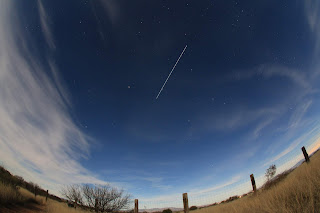Here's a few images from the Total Lunar Eclipse from the night of January 20 (MST). We visited our land in the Dragoon Mountain foothills, setting up my Celestron 8 inch telescope to view the eclipse with my sweetie and some friends. The first image is one taken partway through the total phase and is a combination of 5 images with exposures ranging from 1/2 second at ISO 1600 up to 8 seconds, using my Canon 6D attached to my C8. This HDR combine shows the best of all 5 exposures.
This second image is a view of the flyby of the International Space Station before the start of the Total Lunar Eclipse. The moonlight night was full of lots of cirrus clouds overhead but the ISS made a very nice pass overhead. The image was taken with my Canon 70D and 10mm fisheye lens and an exposure of 30 seconds at f/5.8, ISO 800.























